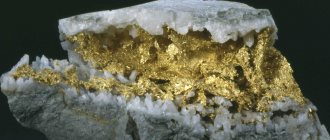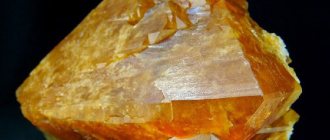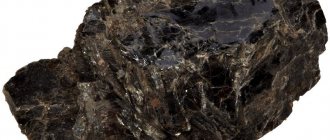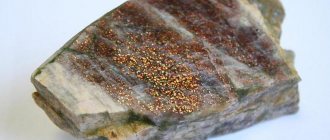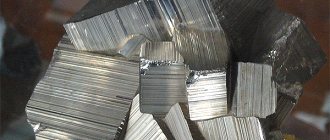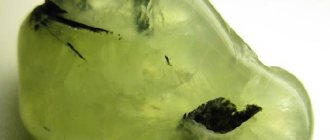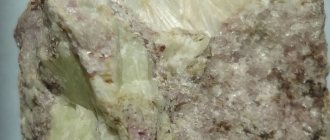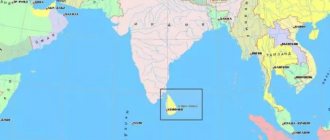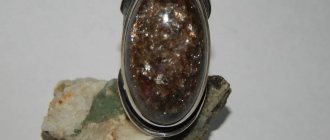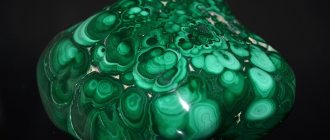Types of gold deposits
Gold deposits occur mainly in areas of granitoid
, a small number of them are associated with basic and ultrabasic rocks.
Gold forms industrial concentrations in post-magmatic, mainly hydrothermal
, deposits.
Under exogenous conditions, visible gold is a very stable element and easily accumulates in placers
.
However, submicroscopic gold, which is part of sulfides
, upon oxidation of the latter, it acquires the ability to migrate in the oxidation zone.
As a result, gold sometimes accumulates in the zone of secondary sulfide enrichment, but its maximum concentrations are associated with accumulation in the oxidation zone, where it is associated with hydroxides of iron
and
manganese
.
Migration of gold in the oxidation zone of sulfide deposits occurs in the form of bromide
and
iodide
compounds in ionic form.
Some scientists allow the dissolution and transfer of gold with ferric oxide sulfate
or in the form of a suspension suspension.
They differ:
- primary gold deposits,
- placers into which it falls as a result of the destruction of ore deposits
- and deposits with complex ores in which gold is extracted as a by-product.
Indigenous gold and placers
Gold ores and placers are natural mineral formations, the content and total amount of gold in which are sufficient for the economically viable extraction of this metal. Gold is found in ores mainly in native form. It is not chemically pure, but is a solid solution with other metals, mainly silver. In addition, gold in ores is present in the form of tellurides (calaverite AuTe2, etc.), but they are not of great industrial importance. Gold deposits are divided into primary and alluvial.
Primary gold deposits
Primary deposits are represented by veins, vein systems, deposits and zones of veinlet-disseminated ores of various sizes and shapes. Ore bodies are confined to cracks, zones of crushing and shearing of rocks. Their thickness is from 0.05 to tens of m, their length is tens and thousands of m. The largest zones are: the Kolar vein zone in India (length 20 km, developed to a depth of 3.2 km, with an average thickness of the veins 1.2 m), the system lived Mather Lode in the USA (length 200 km); some vein zones of the Yenisei Ridge, mineralized zones of the Muruntau deposit in Central Asia. Gold deposits are known in fold belts, on platforms and in areas of tectonic activation.
Gold ore deposits were formed in different geological eras (from Precambrian to Cenozoic), at different depths (from tens of meters to 4-5 km from the earth's surface), usually in connection with large faults in the earth's crust, forming the so-called. gold belts. Their origin is associated mainly with the activity of hydrothermal waters. The mineral composition of gold ores is varied: quartz and iron sulfides (pyrite, marcasite) predominate, less often arsenic (arsenopyrite); there are sulfides and sulfosalts of copper, lead, zinc, bismuth, antimony, silver, oxides, carbonates. According to the composition and conditions of formation, the following formations are distinguished: 1) gold-sulfide-quartz, represented by quartz veins and streaks containing from 0.5 to 30% sulfides; gold is small and large (nuggets are also found), unevenly distributed, its content ranges from 10-50 to 1000 g/t (USSR, Canada, USA, Brazil, India, Commonwealth of Australia, Ghana, Southern Rhodesia); 2) essentially sulfide, represented by deposits, zones of veinlets and disseminated mineralization; finely dispersed gold, its content rarely exceeds 1-2 g/t, is extracted along with other metals - copper, zinc, lead, nickel (Tanzania, Namibia, Canada, Mexico, Australia).
Oxidation zones of ores (iron hats) of some copper-pyrite and polymetallic deposits are enriched with gold redeposited from primary ores and are independent objects for the extraction of the latter. Most of these deposits are located in the USSR (in the Urals and Kazakhstan).
Gold placers
Gold placers are gold-bearing loose (less commonly cemented) deposits of clastic material formed as a result of the destruction of bedrock deposits and gold-bearing rocks. According to the conditions of formation, the following main types of placers are distinguished: eluvial, deluvial, alluvial, coastal, marine and lacustrine. Alluvial placers, including modern riverbeds, valleys and terraces, as well as ancient buried ones, are of the greatest industrial value. The length of placers is from 1-3 to 25 km, rarely up to 50 and 100 km, with a width from 1 m to 200-300 m, sometimes up to 1 km or more; thickness 1-3m. Gold content is from tenths of g/m3 to tens of kg/m3. Gold placers were formed in different geological eras. Ancient placers are often buried under younger sediments and lie at a depth of 100-150 m from the surface of the earth. The richest gold placers are known abroad - in Canada (the basin of the Yukon and Klondike rivers), the USA (Alaska, California), Colombia, the Commonwealth of Australia, New Zealand, New Guinea, the Philippines; in the USSR (the basins of the Yenisei, Lena, Bodaibo, Vitim, Aldan, Kolyma, Yana and Indigirka rivers).
A special type of gold deposits is metamorphosed placers.
(gold-bearing conglomerates, less commonly gravelites). This type includes the world's largest gold deposit, the Witwatersrand in South Africa. (Source - https://studbooks.net/2401163/matematika_himiya_fizika/korennye_mestorozhdeniya_zolota)
Primary gold deposits
Primary deposits, also called endogenous, are the primary source of gold, layers raised by magma from inside the earth’s crust as a result of deep processes. The ores that form primary gold deposits are distinguished by a variety of mineral composition.
The magmatic type of gold-bearing deposits includes large copper-nickel deposits, in which gold is contained mainly in sulfides and is extracted along the way in the process of extracting copper, nickel, platinum and other metals. The gold content of igneous gold deposits is low, but due to their large scale, these deposits can produce quite a lot of gold.
In addition to gold-bearing deposits of the magmatic type, I also distinguish pegmatite deposits (gold-bearing veins inside cracks in igneous rocks) and skarn deposits (the presence of gold at the boundary of the contact between granite and dolomite rocks). But these gold-bearing deposits are practically not sources of gold, both because of their small quantity and because the concentration of gold in the forming rocks is too low.
Types of gold ores
Gold is found 1) in all endogenous genetic types of ore deposits (with the exception of pegmatites), 2) in two types of exogenous ( weathering
and
placer
), as well as 3) in metamorphosed deposits. Hydrothermal, placer and metamorphosed deposits are mainly of industrial importance.
Gold ores are natural mineral formations containing gold in quantities at which it is economically feasible to extract it using modern production methods.
In addition to the actual gold ores
Gold-bearing ores
of copper, nickel, lead and zinc, silver, iron (ferruginous quartzites), and manganese, in which gold is an associated component, are known
There are (as mentioned above) endogenous
[underground],
exogenous
[surface] and
metamorphosed
gold ores.
Endogenous gold ores
All [probably, more accurately, most?] endogenous gold ores of hydrothermal
origin. They contain Au from 2-3 to several hundred g/t. They form massive plate-shaped veins (deposits of the Urals, eastern Transbaikalia, Kazakhstan in the CCCP, Porcupine and Kirkland Lake deposits in Canada, Ashanti in Ghana), saddle-shaped veins (deposits of eastern Siberia in the CCCP, Bendigo in Australia), deposits and pipe-shaped bodies of veinlet and stockwork ores (deposits of Uzbekistan in the CCCP, Homestake in the USA).
The composition of [endogenous?] gold ores is varied (up to 200 different minerals). Gold-sulfide-quartz ores predominate (ore minerals from 1.5 to 20%). The main vein mineral is quartz
.
Calcium and iron carbonates, barite, chlorite, sericite, and tourmaline are present in variable quantities. Among the ore minerals,
pyrite
most often predominates ,
and arsenopyrite
. They are subject to pyrrhotite, sulfides and occasionally occurring sulfosalts of copper and lead, zinc, bismuth, silver, iron oxides, native silver, bismuth, and in isolated cases - tellurides.
Hydrothermal gold deposits are quite common. All of them are multi-stage. Divided into plutonogenic
and
volcanogenic
. Plutonogenic associated with granitoid batholiths. They are characterized by ores of relatively simple quartz composition.
Hydrothermal high temperature deposits
Hydrothermal high-temperature deposits of the gold-arsenopyrite formation occur among granitoids and Precambrian metamorphic rocks. The ore bodies consist of quartz veins with visible gold and sulfides, as well as pyritized and silicified zones in the host rocks. Fine, difficult-to-recover gold inclusions are associated with arsenopyrite, pyrite and other sulfides (deposits of the Urals, Kolar in India, etc.). Deposits of this type are widespread.
Hydrothermal medium-temperature deposits
Hydrothermal medium-temperature deposits of quartz-sulfide and gold-quartz formations are represented by veins occurring within massifs of Paleozoic granitoids and in the host sedimentary rocks of the roof. The ores are composed of quartz, carbonates, barite and sulfides - pyrite, chalcopyrite, sphalerite, galena, fahlores, etc. Gold is present in native form in quartz and as an impurity in sulfides. This genetic type is widespread and has great industrial significance. In the CIS it includes some deposits of the Urals, Kazakhstan, Transbaikalia, etc., abroad - the Maternal Shila and Grass Valley deposits in the USA, Kalgoorlie in Australia, deposits in Ghana, Kenya, etc.
Hydrothermal low-temperature deposits
Hydrothermal low-temperature deposits of the gold-silver formation occur in effusive rocks and are spatially associated with areas of young volcanism. Ore bodies are represented by veins and stockwork zones formed at shallow depths. Mineralization is uneven, clustered (bonanza).
The ores contain chalcedony-like quartz, calcite, rhodochrosite, barite, adularia, sulfides, silver minerals, silver gold, and gold tellurides. Examples include the deposits of Transbaikalia and North-East Russia; abroad - Komstock, Goldfield, etc. in the USA, El Oro in Mexico, deposits in Chile, Peru, New Zealand, Indonesia, Japan, Romania, etc. In addition to gold, silver is extracted from ores.
Exogenous gold ores
Exogenous gold ores are contained in placers
, less often - in oxidation zones of gold-bearing sulfide deposits. In placers, gold ores are represented by loose and weakly cemented near-surface deposits that form ore layers and streams (eastern regions, the Urals and others in Russia, California, the Columbia and Yukon river basins, the Klondike River in Alaska in the USA, southern tributaries of the Amazon River, Brazil, etc. ).
Weathering deposits
Weathering deposits are represented by iron and lead caps of sulfide deposits, in which gold accumulates together with iron hydroxides, lead carbonates, and secondary silver minerals. Gold is released in the form of films in caverns and leaching cells. Sometimes, under conditions of free growth, crystals form.
Examples include iron caps of pyrite deposits in the Urals, Balkans, Japan, etc., oxidation zones of polymetallic deposits in Transbaikalia, etc.
Gold placers
Placer gold deposits continue to play a significant role as gold mining targets. The most common alluvial placers containing gold. Alluvial placers, in accordance with the conditions of occurrence, are divided into channel, valley
and
terraced
.
Channel and valley rivers were formed in Quaternary time. They are common in the basins of the Lena, Kolyma, Aldan, Amur, Yenisei and other rivers. Terrace placers formed earlier than valley ones and lie on longitudinal terraces. They are small in size, but the gold content in them is richer than in valley placers. Terrace placers are located in the Lensky district, Aldan, and Kolyma. Rich eluvial gold placers are known in Australia (Kalgoorlie district), where they are a product of lateritic weathering of gold-bearing quartz veins.
Marine placers are found along the seashores. They are formed due to the destruction of quartz veins and ancient coastal placers, poor in gold. The length of the Nome sea placer (Alaska) is 5 km, width 80-100 m. The gold content in the placer is in some places 200 g/t. Buried placers are widely developed. For example, the Jurassic placers of the Urals are buried under marine sediments of Cretaceous age or continental sediments of the Cenozoic; placers of Quaternary age in the North-East and Siberia are covered by glacial deposits.
Metamorphosed gold ores
Metamorphosed gold ores are associated with layers of gold-bearing conglomerates, less commonly gravelites
(Witwatersrand in South Africa, Tarkwa in Ghana, Jacobina in Brazil and Nallaghain in Australia, etc.). Gold in the form of grains, sometimes semi-rounded (size from 5 to 100 microns), is enclosed in quartz-sericite-chlorite cement, as well as in the form of thin veins cutting quartz pebbles. Manifested together with oxides and sulfides of iron and other metals. Au content 3-20 g/t, fineness above 900.
Metamorphosed deposits are represented by gold-bearing conglomerates - a product of transformation of ancient placers, mainly Precambrian. An example is the unique Witwatersrand gold conglomerate deposit in South Africa. However, geological conditions similar to those of the African shield are known on ancient shields of the East European and Siberian platforms, where Precambrian oligomictic and monoquartz conglomerates are recorded. The problem of identifying industrial deposits of gold-bearing conglomerates is of great practical interest.
general characteristics
There are primary deposits (including veins with a gold content of 1...30 g/t) and placers in the form of alluvium (gold content of 0.5...50 g/m³).
In addition to gold-bearing ores themselves, gold-containing ores of copper, nickel, lead and zinc, silver, iron (ferruginous quartzites), and manganese, in which gold acts as an associated component, are known. More than 30 gold minerals have been discovered. The main industrial importance is native gold, secondary - kustelite (Au about 10-20%) and tellurides: calaverite - AuTe2 (40-43% Au), krennerite - (Au, Ag)Te2 (40% Au), sylvanite - (Au , Ag)Te4, (25-27% Au), petzite Ag3AuTe2 (25% Au). Rare - cuproauride - AuCu2, rhodite - Au, Rh, porpecite - Au, Pd, aurostibite AuSb2, maldonite Au2Bi, gold sulfide uytenbogardeite - Ag3AuS2, etc. Associated components of gold ores - Ag, Cu, Pb, Zn, Bi, As, Sb , Te, Hg, W, Sn, Co, Ni. There are endogenous, exogenous and metamorphosed gold ores.
Endogenous gold ores
All endogenous gold ores are of hydrothermal origin. The Au content ranges from 2-3 to several hundred g/t. They form massive plate-like, saddle-shaped veins, pipe-like bodies, veinlet and stockwork deposits.
Rich gold-quartz ore
The composition of gold-bearing ores is varied (up to 200 minerals). Gold-sulfide-quartz ores predominate. Calcium and iron carbonates, barite, chlorite, sericite, and tourmaline are present. Among the ore minerals, pyrite predominates, and arsenopyrite is less common. They are accompanied by pyrrhotite, sulfides and sulfosalts of copper, lead, zinc, bismuth, silver, iron oxides, native silver, bismuth, and in some cases tellurides.
Exogenous gold ores
Exogenous gold ores are concentrated in placers, less often in oxidation zones of gold-bearing sulfide deposits. Gold is found in the form of rolled and semi-rolled grains, flakes (size 0.5-4 mm), sometimes intergrowths with quartz in sand or clayey material containing boulders, pebbles and (or) crushed stone of various types. There are nuggets. Au content - from 100-150 mg/m³ to tens of g/m³, fineness - from 800 to 950. In oxidation zones, gold is concentrated in the lower parts of oxidized ores, mainly in association with iron and manganese hydroxides, with supergene minerals of copper, arsenic, silver, carbonates, kaolinite. Au content - from 2-3 to 10 g/t. Gold-bearing ores form complex deposits, lenses and nests.
Metamorphosed gold ores
Metamorphosed gold ores are associated with layers of gold-bearing conglomerates, less often - gravelites. Gold in the form of grains, sometimes semi-rounded (5-100 microns), is laid in quartz-sericite-chlorite cement, as well as in the form of thin veins that intersect quartz pebbles. Au content 3-20 g/t, fineness above 900.
Extraction of gold ores
The total amount of gold extracted from the bowels of the Earth in the historically foreseeable period, according to experts, exceeds 135 thousand tons. Moreover, more than 40% of this amount is represented by jewelry, 30% is concentrated in state reserves, almost 20% is in the form of bars and coins , and only 10% is used by industry for technical and technological purposes.
At the end of the 20th century, it became profitable to process poor and difficult-to-process ores: to include off-balance reserves into exploitation; to resume the operation of previously “mothballed” quarries and landfills, mines and shafts; process man-made waste from many mining and processing plants. Fundamental changes have occurred in the technology of beneficiation of gold-bearing ores due to heap, as well as heap with cyanization and biological leaching in columns, the “coal in pulp” method, and the improvement of other pyro- and hydrometallurgical methods (for example, autoclave beneficiation of refractory ores). This led to an increase in the profitability of secondary processing of low-grade ores and tailings from processing plants with a gold content of 1.0-0.3 g/t or less.
A sharp reduction in direct costs and overall losses in gold production was facilitated by the rapid transition from underground to open-pit mining (over the period from 1988 to 2003, the share of open-pit mining increased in the world from 30 to 70%) and the active introduction of highly productive equipment in mining operations, when transporting and processing ore.
World gold production in 2009 amounted to 2,572 tons. Largest producers:
- South Africa (220 t. (2008),
- USA (298 tons (2002),
- Australia (225 t. (2009),
- Indonesia (90 t (2008),
- China (313.98 tons (2009),
- Russia (205.2 tons (2009),
- Canada (95 t. (2009),
- Peru (175 tons (2008),
- Uzbekistan (85 t. (2001),
- Ghana (72 volumes (2001).
Beneficiation of gold ores
The enrichment process is a single system in which individual elements are interconnected. It is possible to achieve high results only taking into account a systematic approach, which takes into account the interaction of system elements, that is, in this case, a full range of processes.
Gravity enrichment is undoubtedly one of the most well-known processes. It is to him that history owes the fact that gold was the first metal with which humanity became acquainted several thousand years BC. Nature itself took care of this, freeing gold deposits from the minerals that contained them in the beds of rivers and streams flowing through gold-bearing rocks, giving them such an attractiveness that our distant ancestors could not help but pay attention to. Mass extraction of gold from placers began with gravitational enrichment methods, after which these methods actively “stepped” into the factory technology of processing ores from primary deposits.
Schemes and modes of enrichment of gold ores significantly depend on their mineral composition, destruction, the presence or absence of impurities that complicate the extraction of gold, as well as on the size of gold particles.
Low sulfide bedrock ores
Depending on the size, gold is usually extracted from low-sulfide primary ores using a one- or two-stage gravity-flotation scheme in combination with amalgamation or cyanization. If the ore contains sufficiently large gold, then after the first stage of crushing, gravity enrichment is used. This scheme using gravitational processes allows you to extract up to 80% of gold.
When cyanidating gravity enrichment waste, gold recovery increases to 95%. However, cyanization is unacceptable for ores that contain carbonaceous substances, as well as copper and antimony sulfides. In addition, cyanidation does not extract gold, which is finely embedded in sulfide minerals. In this case, it is advisable to use flotation of gold together with sulfide minerals. With small and uneven inclusions of sulfides and gold, better results can be obtained by beneficiation using staged flotation schemes. However, in the case of receiving waste with a gold content higher than the dump one, they are subjected to gravity enrichment in hydrocyclones or in jigging machines with the return of the sand fraction or concentrate to the beginning of the process or to an independent cyanidation cycle.
Gold-pyrite ores
In gold-pyrite ores, fine gold is usually associated with pyrite, so it is isolated by flotation together with pyrite. To obtain waste with waste gold content, the control flotation front is extended to obtain a finished concentrate in each control operation, which is sent for cyanization. If gold finely disseminated in pyrites is not extracted by cyanization, the flotation concentrate before cyanization is burned at a temperature of 650 - 700 ° C to obtain a porous undercooked substance, which ensures the opening of gold grains. Sometimes, to reduce the loss of gold from waste, cyanidation is used. However, if there is free gold in the ore, during burning it is absorbed by the fusible components of the ore and is not recovered during further cyanidation. In this case, a scheme is used in which the gravity concentrate is subjected to cyanidation with the dissolution of free gold. Cyanization waste is sent to sulfide flotation with further burning and cyanization of the concentrate.
Sulfide gold-copper ores
In sulfide gold-copper ores, gold is not only in a free state, but also finely disseminated in sulfides (mainly chalcopyrite). In addition to copper sulfides, ores usually contain pyrite, arsenopyrite, and pyrrhotite, which also contain gold, but in smaller quantities than chalcopyrite. Such ores, after removing free gold from them by gravitational processes (jigging, beneficiation on sluices) and grinding to a particle size of 70% class - 0.2 mm, are sent to the 1st collective flotation, where xanthate and pine oil are fed. After grinding the flotation waste to a particle size of 95% class - 0.2 mm, free gold is removed from it by jigging, and the classification is discharged to the second collective flotation, which is also carried out with xanthate and pine oil.
The collective concentrate after refining operations is sent to copper flotation, where pyrite is depressed with lime, but at low alkalinity, because gold is depressed in a highly alkaline environment. The resulting gold-copper concentrate, after dehydration and drying, is sent to a copper smelter. During the electrolytic processing of blister copper, which is created during smelting, noble metals go into electrolytic sludge, from which noble metals are extracted at special plants. The pyrite concentrate is sent for cyanidation to extract the gold contained in it. The total gold recovery using this scheme is 90–91%.
Gold-arsenic ores
Gold-arsenic (gold-arsenic) ores are the heaviest beneficiation object, because they can contain up to 10% arsenic in the form of arsenopyrite with a significant amount of thin, almost emulsified inclusions of gold. In addition to arsenopyrite, the ores usually contain chalcopyrite. These ores are very difficult to enrich due to the presence of carbonaceous shales (refractory ores).
Enrichment of gold-arsenic ores is carried out using a combined gravity-flotation scheme. After separation from the original ore by jigging with purification on gravity concentrate concentration tables, the waste from the gravity cycle is sent to flotation with the release of a collective concentrate.
Particularly difficult during the flotation of sulfides are carbonaceous substances that go into the concentrate and significantly increase their yield, but reduce the gold content. In addition, these concentrates cannot be further processed by cyanidation, because carbonaceous shales are a sorbent of the gold-cyanide complex. In this case, the carbonaceous concentrate from the collective concentrate is separated with the addition of lime, foaming agent and kerosene, and the flotation waste of carbonaceous shale with the addition of copper sulfate is divided into gold-pyrite and gold-arsenic concentrates.
Polymetallic ores
In polymetallic ores, gold is usually found in a finely dispersed state in sulfide minerals, primarily in pyrite and chalcopyrite, less commonly in galena and sphalerite, and, in addition, can be in a free state.
The technology for extracting gold from polymetallic ores consists of capturing free gold in a grinding cycle and more completely extracting it with concentrates in which it is associated with the main valuable components.
Gravity enrichment of gold ores
Currently, gravitational concentration of gold is widely used at gold extraction factories in all countries of the world, including those that are the main producers of this metal.
Based on the nature of the processed raw materials, these factories are divided into 3 groups:
- quartz and quartz-sulfide ores containing noble metals mainly in cyanide-soluble form.
- cyanidation-resistant pyrite and arsenic-pyrite ores with finely disseminated gold in sulfides, as well as ores containing sorption-active carbonaceous matter.
- complex ores containing, along with gold and silver, heavy non-ferrous metals (copper, lead, zinc, antimony), as well as uranium.
Within each group, the number of enterprises using the processes of gravity, flotation enrichment and cyanidation is determined (Tables 1, 2).
Table 1. Scope of application of gravity, flotation and cyanidation
| Name indicators | Groups of enterprises | |||
| Simple ore | Persistent ore | Complex ore | Total | |
| Total number of enterprises | 142 | 53 | 44 | 239 |
| Including the number of enterprises using: | ||||
| gravity | 42 | 17 | 19 | 78 |
| flotation | 26 | 36 | 43 | 106 |
| cyanidation | 137 | 47 | 25 | 209 |
Table 2. Gravity enrichment of ores
| Name indicators | Groups of enterprises | |||
| Simple ores | Refractory ores | Complex ores | Total | |
| Number of enterprises using gravity enrichment | 42 | 17 | 19 | 78 |
| Including: as the only technological process | 1 | — | — | 1 |
| in combination with cyanidation | 23 | — | — | 23 |
| in combination with flotation (without cyanidation) | 2 | 3 | 5 | 10 |
| in combination with flotation enrichment and cyanidation | 16 | 14 | 14 | 44 |
Gravity enrichment is practiced by more than 1/3 of enterprises, but gravity is almost never used without combination with other processes.
In recent years, great progress has been made in the technology of gravity enrichment of gold ore raw materials. This is manifested, first of all, in the creation of new devices capable of extracting not only large, but also very small particles of metallic gold, released during the ore grinding process, such as centrifugal concentrators and centrifugal jigging machines, in which the intensity of separation of gold particles and other minerals is less grain density increases many times.
In the vast majority of cases, gravity is used in combination with cyanidation, flotation, or both. For Simple ores, the most typical schemes are gravity and gravity-flotation enrichment with cyanidation of flotation tailings, and in some cases, gravity concentrates. The main purpose of gravity in these options is to remove large free gold from the ore into products (concentrates) that are processed in a metallurgical cycle separate from the bulk of the ore.
In addition to increasing (usually 2-4% of total gold recovery), this makes it possible to prevent or at least significantly reduce the accumulation of gold in grinding and mixing apparatus.
Flotation, like gravitational enrichment, refers to mechanical enrichment methods, when the concentration and separation of mineral components is carried out without disturbing their crystal structure and chemical composition. Such methods may also include magnetic, electrical and radiometric separation (including photometric sorting), separation of minerals by shape and particle size, selective adhesion (collection by sticky surfaces) and some other processes. However, unlike the methods listed above, including gravity ones, flotation is based on the use of chemical reagents that perform a variety of functions.
The basis of flotation enrichment, carried out, as a rule, in an aqueous environment, is the principle of imparting hydrophobic properties to the grains of the extracted component, due to which they are not wetted by water and are “pushed” to the boundary of the liquid and gas phases, even if the density of these grains is many times higher than the density water.
Hydrophobicity is imparted to mineral grains by collector reagents (collectors) introduced into the suspension and fixed on the surface of the extracted particles, for example sulfides. The process of separating the latter from the rest of the ore mass (“tailings” of flotation) is intensified by aerating the pulp with air, using special foaming agents and reagents that depress the flotation of gangue minerals, as well as by regulating the pH value, i.e. creating an acidic, alkaline or neutral pulp environment.
Thanks to the extremely wide range of flotation reagents, the total number of which is about 6-8 thousand, it is possible to concentrate virtually any minerals by flotation. On the same basis, principles and methods of separation (selection) of various mineral mixtures have been developed to obtain individual products (concentrates) that meet market requirements and the conditions for their subsequent use or chemical and metallurgical processing. In this regard, flotation, as a method of mechanical enrichment of mineral raw materials, has very great potential, which determines its widespread use in various industries, including non-ferrous and ferrous metallurgy, the coal industry, in the production of diamonds, graphite phosphorus, barite, magnesite, pure koalin clays and other mineral products. Currently, more than 2 billion tons of minerals are processed annually by flotation, and this is the best characteristic of this technological process.
Flotation plays a fairly important role in the beneficiation of gold ore raw materials. However, this takes into account one important circumstance that distinguishes the flotation capabilities of gold ores from most non-ferrous metal ores. The latter are characterized by a clear division of the main technological stages: ore dressing and metallurgical processing of concentrates. These stages are carried out at individual enterprises (concentration plants, metallurgical plants), which are often part of various production associations. At the same time, the overwhelming majority of gold extraction factories operate according to schemes with a complete cycle of ore processing to the final marketable product - gold bars (Dore alloy). For this reason, ore processing at gold mining enterprises is usually carried out using combined schemes, combining gravity-flotation enrichment operations with cyanidation and other chemical and metallurgical operations (smelting, roasting, autoclave or biochemical oxidation, etc.).
Flotation beneficiation of ores at gold recovery factories
| The name of indicators | Groups of enterprises | |||
| Simple ores | Refractory ores | Complex ores | Total | |
| Total number of enterprises analyzed | 142 | 53 | 44 | 239 |
| Of these, flotation enrichment is used | 26 | 36 | 43 | 105 |
| including: as the only technological process | — | 3 | 13 | 16 |
| in combination with cyanidation and gravity | 26 | 33 | 30 | 89 |
According to flotation activity in ores, gold-containing minerals can be arranged in the following sequence (in descending order):
- intergrowths of metallic gold with iron sulfides (pyrite, arsenopyrite) and sulfides of heavy non-ferrous metals (chalcopyrite, galena, etc.);
- actual gold-bearing sulfides, in which gold is present in the form of thin metallic inclusions;
- free grains of gold and natural alloys of gold and silver (electrum, kustelite, etc.)
The greatest effect from the use of flotation is achieved when extracting gold from ores with predominantly sulfide mineralization. Flotation is used extremely rarely for oxidized gold ores, since it does not provide satisfactory recovery of metal into concentrates, being much inferior in this regard to the process of direct cyanidation of ore. However, the use of flotation turns out to be very useful in the process of mineralogical studies for isolating fine grains of free gold from oxidized ores for their subsequent microscopic examination in order to establish the size and morphology of gold grains. As a rule, the flotation process of gold ores is carried out in a slightly alkaline environment (pH = 7-9). To create such an environment, soda or lime is used (the latter is used less frequently, since it has a weak depressive property in relation to gold-bearing pyrite, and to some extent, to native gold).
Ethyl or butyl xanthates are used as collectors. Pine oil or cresol is usually used as a foaming agent. To activate pyrite, copper sulfate is fed into the pulp (during grinding).
Depression of gangue minerals, including clays, is produced by silicate and (less commonly) sodium sulfide. The latter is also used for sulfidation of the surface of particles of oxidized minerals (malachite, azurite, cerussite, anglesite, smithsonite, etc.) in order to impart flotation activity to them.
For the flotation of gold and silver ores, depending on their material composition, a variety of devices are used: multi-chamber mechanical, pneumomechanical, pneumatic, as well as large-volume (tank) flotation machines. In recent years, flotation columns have been developed and are successfully operating at a number of gold mining enterprises, designed for the enrichment of finely ground and slurry ores for the concentration of native gold and coarse gold-containing sulfides in ore grinding cycles. Flash flotation is seen as an alternative to gravity methods for extracting gold from “freshly crushed” ores and is effectively used in factories.
Flotation is used extremely rarely as the only technological process. These are mainly enterprises processing complex ores, which, along with gold and silver, contain other non-ferrous metals (copper, lead, zinc, antimony) in concentrations and mineral forms that allow the possibility and economic feasibility of the associated extraction of these metals into liquid marketable products. Carrying out flotation in a special reagent mode makes it possible to isolate copper, lead, zinc and antimony concentrates of standard composition from gold ores, which are sent for subsequent processing to specialized metallurgical plants. During flotation, a significant portion of the noble metals present in the feedstock also passes into these concentrates. The possibilities of their subsequent extraction are determined by the technology of the main metallurgical production.
The main strategy of gold mining enterprises carrying out complex processing of polymetallic ores, in addition to obtaining quality concentrates of non-ferrous metals through flotation, is to ensure the maximum possible extraction of gold on site using other technological processes, in particular gravity enrichment and cyanidation. This kind of combined gravity-flotation-cyanide technology for processing complex ores is practiced by most enterprises.
Favorable objects for the use of flotation are technologically resistant ores, in which gold is closely associated with iron sulfides and cannot be extracted by cyanidation without the use of rather complex and expensive preparatory processes: oxidative roasting, autoclave or biochemical oxidation of sulfides.
Flotation allows not only to concentrate gold-containing sulfides (pyrite, arsenopyrite) in a small volume of concentrate sent for metallurgical processing, but also to separate these sulfides, for example, pyrite and arsenopyrite or pyrites of various generations, differing in gold content.
As one of the options, the enrichment of low-grade gold ores (Au 2.2 g/t) occurs using a combined gravity-flotation technology. In the flotation process, a special activator of metallic gold and gold intergrowths with pyrite is used. In combination with potassium amyl xanthate (pyrite collector) and carbon dioxide introduced into the pulp to maintain the optimal pH value = 8.4-8.6, the reagent makes it possible to extract 85% of gold into the concentrate while retaining about 75% of the pyrite present in the flotation tailings mainly fractions that do not contain gold. Taking into account gravity, the total recovery of gold into concentrates at the plant is more than 90% - with a concentrate yield of only 1.9% of ore.
When processing carbonaceous sulfide ores, improving the quality and reducing the yield of gold-containing concentrates is achieved through preliminary flotation removal of waste coal fractions from the ore in terms of gold content, or through sequential flotation of carbon and sulfides with careful selection of the reagent regime at each stage.
If there is a simultaneous presence of refractory (in sulfides) and easily cyanidated gold in ores, flotation enrichment is supplemented with a cyanidation operation, which is subjected to either the original ores before flotation or the tailings of flotation enrichment. The pyrite and arseno-pyrite concentrates obtained during flotation are also processed on site by cyanidation, but only after preliminary chemical, thermochemical or biochemical exposure of gold-bearing sulfides.
At enterprises processing ores of simple composition with relatively easily cyanidated gold, flotation is used only if it ensures the production of waste tailings containing gold and if at the same time the costs of hydrometallurgical processing are significantly reduced, since not the entire mass of ore is subjected to cyanidation, but only flotation concentrates.
Flotation has become an extremely diverse process in terms of the reagents used and the equipment used, which makes it possible to use it much more widely than before, including on low-grade and complex ores. Due to flotation, it is possible to increase gold recovery and ensure acceptable profitability of deposit development. At the same time, the multivariate nature of the process requires versatile and thorough laboratory and technological studies of ores, as well as extensive experience and knowledge, in order to find exactly the option that will provide the best effect for specific conditions.
The basis of modern technology for extracting gold and silver from ores of primary deposits is cyanidation, which consists of selective leaching of noble metals with aqueous solutions of alkaline cyanides: sodium, potassium, calcium. Then the dissolved metals are separated from the solutions by various methods to ultimately obtain high-quality commercial products - metal ingots (Dore metal), sent to refineries. In some cases, the refining of gold and silver is carried out directly on site, i.e. in the conditions of a gold mining enterprise.
It should be noted that in previous times, cyanidation of gravity concentrates containing large particles of gold and other heavy minerals (in particular sulfides) in tank-type devices (mechanical and pneumomechanical agitators) was considered unacceptable due to the low rate of dissolution of gold and the difficulties of maintaining the suspension in suspension. condition, which resulted in the settling of heavy fractions at the bottom of the apparatus. Currently, these problems are being solved through the use of horizontal drum mixers, as well as devices with forced circulation of cyanide solutions and cone reactors. These devices allow cyanidation of gold-containing gravity concentrates with almost any granulometric characteristics. Thus, the traditional technology of gravitational concentration of gold with deep finishing of primary concentrates to rich “gold heads”, suitable for smelting into gold-silver alloy (Doré metal), is complemented by an alternative method of hydrometallurgical processing of concentrates with moderate metal content, after their one- or two-time refining on concentration tables or other finishing devices.
The effectiveness of this option increases even more if not only gravity concentrates are subjected to cyanidation, but also tailings from gravity enrichment of ore (using a “softer” leaching mode), since in this case it is possible to direct the solid residues of the “concentrate” cycle into the general hydrometallurgical process with ultimately obtaining a single commercial product.
The history of the world mining and metallurgical industry, most likely, does not know other examples of such dynamic development and mastery of technological processes, such as cyanide leaching of gold. This is evidenced, for example, by the following figures. The cyanidation process was patented in October 1887. The following year, 1888, a demonstration semi-industrial installation was created, and in 1889, the world's first factory for cyanidation of gold ores was built. A year later, the second industrial cyanidation plant came into operation, the production of gold in which in 4 years increased from 9 kg (1890) to 9 tons (1893), i.e. a thousand times. The subsequent rapid development of cyanidation technology led to the fact that this process very quickly took a leading place in the overall world production of gold from ore raw materials, which over 110 years (1890-2000) grew from 200 to 2500 tons per year. Over the past 20 years, 92% of the world's gold has been obtained from the ores of primary deposits using cyanidation (the remaining 8% is the share of metal extracted along the way from the ores of heavy non-ferrous metals: copper, lead, antimony, etc.).
The technological advantages of cyanidation, carried out using solutions with a very low concentration of cyanide (0.3-1 g/l and below), lie, first of all, in the fact that it is carried out in a slightly alkaline environment (pH = 9.5 ~ 11.5) at normal (“room”) temperature and atmospheric pressure, which determines the high economic efficiency of cyanidation of gold ores.
An important role was played by the developments of the US Bureau of Mine (US BM) on the adsorption extraction of gold from cyanide media with granular activated carbons (1952) and heap cyanide leaching (HC) of lump ores and ore dumps (1969).
The first commercial carbon adsorption gold heap leaching facility was established in 1974 for rock dumps containing less than 2.5 g/t gold, which at that time made it unprofitable to process them using conventional mill technology. In the 1980s, the KB process became extremely widespread in the gold mining industry in the United States, and then in other countries. This was facilitated by the next development of USBM for the preliminary agglomeration of finely crushed and slimy ores before KB (1979). In Russia, over the past 10 years, about 20 industrial enterprises have been created that carry out heap leaching of gold ore raw materials, with a total processing volume of more than 5 million tons per year.
As a rule, open-pit ores with a gold content of 0.5 to 1.5 g/t are subjected to heap leaching, from which 50 to 80% of the metal is recovered by cyanidation. This ensures the profitable operation of enterprises of various sizes: from 0.5 to 15 million tons of ore per year. Sometimes combinations of heap and dam ore leaching operations are used.
The bulk of the ore is subjected to heap leaching after preliminary crushing to 65 mm and agglomeration of the crushed ore with lime and cyanide solution. Processing of low-grade ores (Au less than 0.5 g/t) is carried out without crushing and agglomeration using the dam leaching method. The recovery of gold into solutions is 70%, incl. 80% - with heap leaching and 65% - with dam leaching.
Another direction for increasing the efficiency of the hydrometallurgical process is the integration of heap and dam leaching operations with factory cyanidation technology.
The dam leaching process is carried out on ore of “bottom-hole” size without preliminary crushing. Gold is extracted from solutions in a separate installation. Gold-saturated coals from both leaching cycles are combined and eluted using standard technology. The total gold recovery is 90%, including in the factory technology cycle - 95% and in dam leaching - 73%.
The possibility of cost-effective processing of low-grade gold ore materials by cyanidation is confirmed by the practice of enterprises that carry out additional extraction of gold from stale enrichment tailings of previous years. This issue, given its significance (including for the Russian gold mining industry), deserves special consideration in a separate publication. Here it should only be noted that taking into account the minimal costs for the development of this type of “technological” gold deposits and the preparation of stale tailings for subsequent hydrometallurgical processing (cyanidation using factory technology), the profitability of the process is ensured when gold recovery is at the level of 0.4-0.5 g/ t of feedstock.
The objects of cyanidation application are not only poor, but also fairly rich gold-containing materials, in particular, concentrates from flotation and gravity concentration of ores.
As for gravity gold-containing concentrates, until recently the only acceptable method of processing them was considered to be deep finishing (cleaning) followed by smelting the resulting “gold heads” into metal ingots. However, special devices have now been created that allow large grains of metallic gold to be leached with cyanide solutions.
An important area of use of the cyanide process is the processing of refractory ores and concentrates. These include materials containing dispersed inclusions of gold in dense and cyanide-insoluble grains of iron sulfides: pyrite and arsenopyrite. The possibility of processing such materials using “cyanide-free” hydro- or pyrometallurgical methods has been studied for a long time. But no positive results were obtained from an economic point of view. Therefore, almost all currently operating gold mining enterprises extract gold from refractory pyrite and arsene-pyrite ores (concentrates) using the same cyanide process, but only after additional mechanical (fine and ultra-fine grinding), chemical (autoclave oxidation), thermochemical (roasting) or biochemical opening of gold-bearing sulfides. As a rule, these preparatory operations cost much more than cyanidation itself. However, collectively they provide high gold recovery into the final marketable product and the overall economic efficiency of the technological process.
Cyanidation also plays a significant role in the processing of complex gold ores containing copper, lead, antimony, zinc and other heavy non-ferrous metals, the associated extraction of which seems technologically possible and economically feasible.
Gold minerals
More than 30 gold-containing minerals have been discovered in nature.
Of these, 15 are gold minerals:
- native gold with admixtures of silver, copper, etc.,
- electrum Au and 25-45% Ag,
- porpesite AuPd,
- cuprous gold,
- bismutaurite (Au, Bi),
- native gold,
- iridescent gold,
- platinum gold
- golden silver - kustelite
(Au approx. 10-20%) - and others
The remaining gold-bearing minerals are represented by gold tellurides
:
- calaverite AuTe2 (40-43% Au),
- krennerite (Au, Ag)Te2 (approx. 40% Au),
- sylvanite (Au, Ag)Te4 (25-27% Au),
- petzite Ag3AuTe2 (25% Au),
- mutmanite (Ag, Au)Te,
- montbraite Au2Te3,
- nagiagite Pb5AuSbTe3S6
.
Gold is characterized by native
form.
Among its other forms, it is worth noting electrum
- an alloy of gold and silver, which has a greenish tint and is relatively easily destroyed when transferred by water.
In rocks, gold is usually dispersed at the atomic level. In deposits it is often enclosed in sulfides
and
arsenides
.
Native gold is of primary industrial importance
, secondary -
kustelite
and tellurides:
calaverite
,
krennerite
,
sylvanite
,
petzite
.
Very rare are cuproauride
- AuCu2,
rhodite
- Au, Rh,
porpecite
- Au, Pd,
aurostibite
- AuSb2,
maldonite
- Au2Bi, gold sulfide
uytenbogardeite
- Ag3AuS2, etc. Associated components of gold ores themselves - Ag, Cu, Pb, Zn, Bi, As, Sb, Te, Hg, W, Sn, Co, Ni.
In nature, there is a natural alloy of gold and silver called electrum. When developing ore deposits of solar metal, accompanying valuable chemical elements are extracted from the rock: iridium; platinum; osmium; ruthenium; palladium; nickel; copper.
Native gold
| Native gold is a natural solid solution of Au + Ag. The silver content in native gold is up to 10%. There are signs of discontinuity in this series: significantly different prevalence of native gold of different grades (prevalence 930-900, 820-780, 650-600, extreme rarity - 550) to golden silver - the so-called. kustelita . Characteristic is the phase heterogeneity of native gold individuals with separation of phases of the composition Ag, Ag3, Au, AgAu. Native solar metal is not a chemically pure material; it always contains impurities: silver (up to 50%); copper (up to 20%); gland; mercury; bismuth; platinum group metals; tellurium Common impurities are Cu (0.001-0.9%), Fe, Mn, Pb, less commonly Bi, Sb, Hg, Te, Se, Pt, In, etc. (0.00n - 0.n%). With increased amounts of impurities, varieties of native gold (mostly rare) are distinguished: cuprous gold, bismuth gold, iridium gold, platinum gold, etc. Natural amalgams of Au are known. Impurities of Ag, Fe and others are often concentrated in the growth zones of native gold individuals and along the boundaries of grains or in their individual areas. Native gold contains inclusions of carbon dioxide and other gases. The composition of native gold depends on the type and depth... |
Placer gold deposits
Exogenous gold deposits are created by processes occurring on the Earth's surface. As a result of exogenous processes, several types of deposits arose, of which the most interesting are deposits of the weathering zone and placers (placer deposits).
Placers are the accumulation of grains (particles) of heavy and relatively resistant to weathering agents useful minerals in loose cemented clastic deposits resulting from the destruction of primary bedrock in relation to placers.
In bedrock, useful minerals are found intergrown with rock-forming minerals. The first condition for the process of placer formation is the disintegration or release of useful components as a result of physical (thermal expansion, disjoining liquid pressure, compression) and chemical (the process of hydration, dissociation and oxidation) weathering.
As a result, the primary concentration of more stable, useful gold-bearing minerals occurs due to the destruction or dissolution of unstable minerals and their transition to secondary fine-grained clay formations, which are easily transported, carried away by their own weight along an inclined surface or a rapid water flow.
Sources of gold-bearing industrial placers are usually primary deposits, ore occurrences and intermediate reservoirs (older and larger placers). However, there is no 100% connection here; not all primary sources are accompanied by placers and, on the contrary, rich and large gold-bearing placers often do not have primary ore sources that are adequate in terms of qualitative and quantitative characteristics.
Palladium.
Palladium is also extracted as a secondary component from copper-nickel, chromium and other ores. The undisputed world leader in palladium mining is the Russian concern OJSC GMAC Norilsk Nickel, accounting for about 40% of global palladium production. The company also mines ore on the Kola Peninsula in the Murmansk region. The world's second most important source of palladium is the Bushveld complex in South Africa. This unique deposit also provides about 40% of the world's palladium production and is the world's largest in terms of reserves of platinum group metals.
Silver.
The silver content in the earth's crust is approximately 70 mg per ton. It is less common in its native form and is more often found in deposits with other minerals. Basically, silver is extracted from gold, silver, copper, lead-zinc ores - as an associated component, but the extraction of silver is not always economically profitable and feasible. Sea water is also a promising source of silver production; the silver content in sea water is much higher than in the earth’s crust. The most significant reserves of silver are concentrated in Peru - 120,000 tons.
